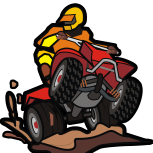By
kiriyaaoi
Hello everyone, I just picked up an 02 LT-F250F the other day and have been in the process of tearing it down to fix some stuff- one of which was the cylinder base gasket leaking like a sieve. Well, I know why that is now, and I also discovered that someone had been in there before. I didn't take pictures, but it looks like it was probably run low on oil at some point, the cam journals and the "bearings" (for lack of a better term) in the head and the valve cover are totally wiped out, very deep grooves. From what I know it's very difficult to repair aluminum in this way, so I'm trying to figure out where to go next.
1. Have someone grind down the head and valve cover and fit actual bearings in since the aluminum is screwed, and have the cam ground down to match. I have no idea what this would cost.
2. Buy a replacement head+cam+valve cover.
#1 I was hoping someone might have some advice on, but #2 seems like it'll (probably) be the more cost effective option. However I'm running into some difficulty, it seems like the 2001 and 2002 models specifically use a different head part number, 11100-19B10, instead of 11100-19B01 like for all earlier models. What exactly is the difference between them? There are obviously far more of the earlier heads because it ran for over 10 years. Are they actually interchangeable? I've also noticed there are heads from the LT250EF that has 4 valve heads but also otherwise look identical. Would those work as well possibly? I'd like to not have to drop $500 on machine work or new heads on a $1300 quad that I'm already putting a bunch of new parts on. Oh, and it has a new piston and the cylinder itself looks pretty good too, as I said someone was in here before me.
Any help or advice would be greatly appreciated. I'll post pics of the carnage tomorrow.









Recommended Posts
Join the conversation
You can post now and register later. If you have an account, sign in now to post with your account.
Note: Your post will require moderator approval before it will be visible.